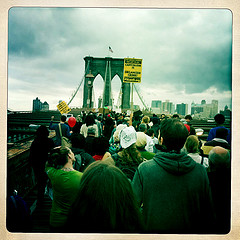
Sociologist Frances Fox Piven is one the most dangerous people in the world (at least, Glenn Beck thinks so). So why would Salon sit down with her? She’s also an expert in social movements. Reporter Josh Eidelson goes in depth with Fox Piven on the continued power of the Tea Party, the Occupy Movement, and the power of youth.
One of Piven’s most interesting points regards the power of disruptive movements. She discusses the Occupy Wall Street Movement and its offshoots, asserting that two of its most successful strategies were flamboyance and the ability to disrupt business. These strategies have yielded success for Occupy, but also for a larger ambition for social change. Indeed, as Piven points out, Occupy influenced the rhetoric of American politics and helped show that the grassroots power of other decades is far from gone. She even believes working outside the system is now the most effective path to progress:
“Going to Washington is largely a waste of time. But causing trouble is not.”


